
Winterkill of cover crops in zone 6
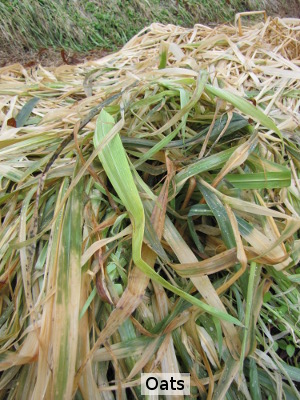 When
I summed up 2010's no-till
cover crop experiments,
the only question left was how various crops would winterkill here in
southwest Virginia. Now that the traditional coldest month of the
year is just about over (and the garden is finally free of a coat of
snow), I went out to check on the state of the cover crops. For
those of you who haven't been following along, I was looking for the
opposite of what gardeners usually aim for --- dead plants so that I won't have
to till them in. Here's what I saw:
When
I summed up 2010's no-till
cover crop experiments,
the only question left was how various crops would winterkill here in
southwest Virginia. Now that the traditional coldest month of the
year is just about over (and the garden is finally free of a coat of
snow), I went out to check on the state of the cover crops. For
those of you who haven't been following along, I was looking for the
opposite of what gardeners usually aim for --- dead plants so that I won't have
to till them in. Here's what I saw:
- Oats have a green leaf
here and there, but look pretty much dead. If any of the plants
sprout back up when warm weather comes, it won't be hard to mow them
down, but I suspect I won't have to do that. It looks like the
remains of the oats will make a good mulch for the coming growing
season.
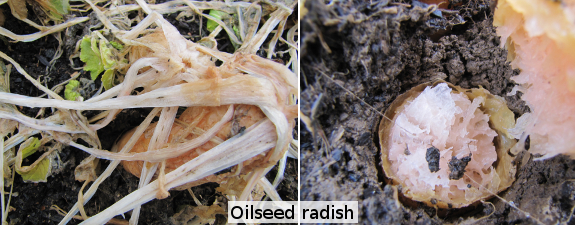
- Oilseed radishes have a
wisp of green here and there, but the plants are clearly dead --- I can
easily tear the huge taproots apart with gentle pressure. Inside,
the roots are soft, spongy, and mostly decomposed already. The
plus side is that the biomass will probably have melted into the soil
enough that crops I plant in old oilseed radish beds can use the
nutrition this coming year. The flip side of the coin is that I'm
going to need to mulch the oilseed radish beds soon because bare ground
will quickly grow full of weeds now that the snow is gone. As a
final note, I feel that I should mention that the stench most websites
report from their decomposing oilseed radishes didn't
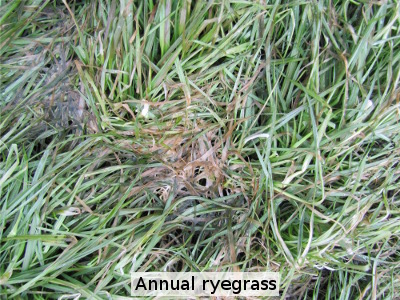 materialize in my garden, perhaps because the
radishes spent so long under a coat of snow.
materialize in my garden, perhaps because the
radishes spent so long under a coat of snow.
- Annual ryegrass is still
mostly green, so it looks like I'm going to need to find a way to
kill it. I've read that ryegrass is easy to mow-kill, so
that will be my first option.
- Buckwheat is frost tender
and is long gone.
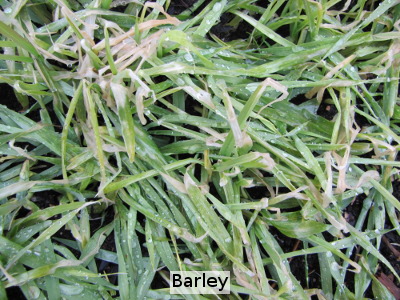 Barley
is still green, despite the fact that I planted it in late October and
the plants only got a couple of inches tall before growth ceased for
the winter. I'd be tempted to leave it alone and see what it does
this spring, but the barley is located in beds that are slated to go
back into early spring vegetable production. So I'll probably
just weed or smother the baby barley out.
Barley
is still green, despite the fact that I planted it in late October and
the plants only got a couple of inches tall before growth ceased for
the winter. I'd be tempted to leave it alone and see what it does
this spring, but the barley is located in beds that are slated to go
back into early spring vegetable production. So I'll probably
just weed or smother the baby barley out.
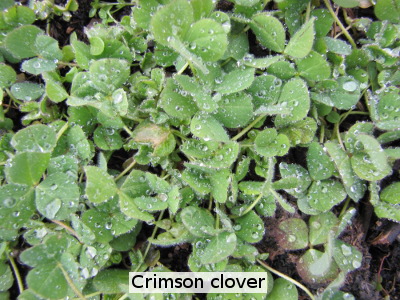 Crimson
Clover is still bright green and small. Unlike the other
cover crops I'm trialing, the clover is a legume, which means its
benefit isn't so much adding biomass to the soil as adding
nitrogen. Some people have good luck leaving crimson clover as an
intercrop among large vegetables, so I'm going to see if the clover can
share beds with broccoli and other large crops this spring.
Crimson
Clover is still bright green and small. Unlike the other
cover crops I'm trialing, the clover is a legume, which means its
benefit isn't so much adding biomass to the soil as adding
nitrogen. Some people have good luck leaving crimson clover as an
intercrop among large vegetables, so I'm going to see if the clover can
share beds with broccoli and other large crops this spring.
Based on this winterkill
data, I've got some changes to make for next year. I think I'm
going to delete ryegrass from my winter cover crop rotation, plant
barley and crimson clover in the shady part of the garden where I don't
start vegetables until May and could allow the cover crops to mature in
the spring, plant oats where I want a mulch the next summer, and plant
oilseed radishes where I want to direct-seed early spring crops.
It's great to finally be wrapping my head around the niche of each
cover crop.
Want more in-depth information? Browse through our books.
Or explore more posts by date or by subject.
About us: Anna Hess and Mark Hamilton spent over a decade living self-sufficiently in the mountains of Virginia before moving north to start over from scratch in the foothills of Ohio. They've experimented with permaculture, no-till gardening, trailersteading, home-based microbusinesses and much more, writing about their adventures in both blogs and books.
Want to be notified when new comments are posted on this page? Click on the RSS button after you add a comment to subscribe to the comment feed, or simply check the box beside "email replies to me" while writing your comment.
